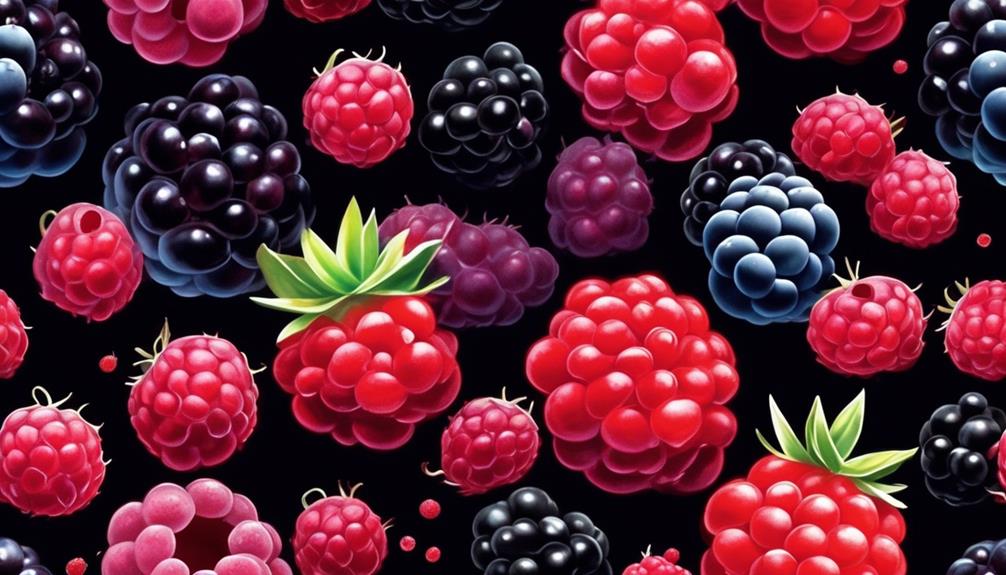As you step into the enchanting world of berries, the twined tales of bittersweet unfold before you like a delicate dance of nature’s duality.
Like two sides of a coin, American Bittersweet and American Wahoo embody contrasting flavors, stories, and cultural significance. These vibrant berries, bursting with color and emotions, hold a captivating allure.
But beware, for hidden within this botanical beauty lies a cautionary tale of invasive species.
In this discussion, we will explore the complex nature of these berries, their origins, and the importance of preserving their delicate balance.
So, prepare to embark on a journey that will both tantalize your taste buds and leave you pondering the intricate harmony of nature’s creations.
Nature’s Contrasting Flavors
When it comes to nature’s contrasting flavors, the bright berries of bittersweet plants offer a tantalizing blend of sweetness and bitterness.
Two main types of bittersweet plants can be found in North America: American Bittersweet and Oriental Bittersweet. While American Bittersweet is native to the continent, Oriental Bittersweet is considered highly invasive. It spreads rapidly through bird-dispersed seeds, posing a threat to large trees.
To combat the invasive nature of Oriental Bittersweet, American Wahoo is recommended as a replacement. This small tree or shrub, native to eastern North America, boasts visually striking bright red fruits.
Both American Bittersweet and American Wahoo belong to the Celastraceae family, with only a few genera growing in temperate areas. With their vibrant fruits, these plants can add interest to home landscapes, but caution must be exercised to avoid planting their invasive relatives.
Story and Origins
To understand the story and origins of these bittersweet plants, let’s explore their historical significance and cultural connections.
Bittersweet plants, such as American Bittersweet and Oriental Bittersweet, have bright berries that are often used in fall wreaths and decorations. Oriental Bittersweet, however, is considered one of North America’s most invasive plants, spreading its seeds through birds and strangling large trees with its vines.
On the other hand, American Wahoo, a native shrub or small tree, boasts visually striking bright red fruits inside pink capsules. Both American Bittersweet and American Wahoo belong to the Celastraceae family, with their fruits revealed upon opening colorful capsules.
While these plants can be enjoyable additions to home landscapes, it’s crucial to avoid planting their invasive relatives.
Cultural Significance
Bittersweet plants and American Wahoo hold cultural significance due to their vibrant berries and historical connections.
The bright berries of bittersweet plants are often used in fall wreaths and decorations, representing their cultural importance in seasonal festivities. These plants add a touch of natural beauty and tradition to home landscapes.
Similarly, American Indians traditionally planted American Wahoo around their camps for protection. Its bright red fruits symbolized strength and served as a connection to cultural traditions.
However, it’s crucial to be mindful of avoiding planting invasive species like Oriental Bittersweet, as they can harm ecosystems and native plant species. The Celastraceae family, to which bittersweet plants belong, also holds cultural and historical significance, particularly in temperate areas.
Berry Colors Represent Emotions
The emotions and symbolism associated with berry colors add depth and meaning to nature-inspired designs and decorations.
Different berry colors represent a range of emotions and moods. For example, red berries symbolize passion and love, evoking feelings of energy and vitality. Blue berries, on the other hand, convey calmness and serenity, creating a sense of peace and tranquility. Purple berries represent royalty and mystery, adding an air of elegance and intrigue.
The vibrant hues of berries, like the bright red of strawberries and the deep purple of blackberries, bring joy and playfulness to nature. Additionally, the changing seasons are reflected in the rich colors of berries, with the greens of spring and the warm reds and oranges of autumn.
Understanding these emotions and symbolism can enhance the impact of nature-inspired designs and decorations.
Berries Preservation Techniques
Preserving berries can be achieved through various techniques such as freezing, drying, canning, and making preserves or jams.
Freezing berries is a simple and effective way to preserve them while maintaining their flavor and nutritional value. You can just wash and dry the berries, place them in airtight containers or freezer bags, and store them in the freezer for later use.
Drying berries can be done in a dehydrator or oven at a low temperature to remove moisture and preserve them for long-term use.
Canning berries involves packing them into sterilized jars and processing them in a hot water bath or pressure canner to create shelf-stable preserves.
Lastly, making preserves or jams involves cooking berries with sugar and pectin to create a spreadable product that can be stored for an extended period.
With these preservation techniques, you can enjoy the delicious taste of berries all year round.
Gift-Giving Occasions
Now that you’ve learned about various techniques for preserving berries, let’s explore the perfect occasions for giving these delightful fruits as gifts. Whether you’re looking for a festive decoration, a symbolic gesture, a thoughtful addition to a home landscape, or a unique gift for outdoor enthusiasts, bittersweet plants and American Wahoo offer a range of options. Consider the following table to help you choose the ideal gift-giving occasion:
| Occasion | Recipient |
|---|---|
| Fall decorations | Festive home decorators |
| Nature appreciation | Nature enthusiasts |
| Gardening | Gardeners or homeowners |
| Outdoor activities | Hikers or outdoor enthusiasts |
Remember to avoid their invasive relatives, such as Oriental Bittersweet and burningbush, to protect the environment. With their vibrant colors and natural beauty, bittersweet plants and American Wahoo make for memorable and meaningful gifts.
Concluding Thought
To wrap up our discussion on the diverse nature of berries, let’s reflect on their captivating beauty and versatility.
Berries, such as those found on bittersweet plants, add a touch of color and charm to fall decorations and wreaths.
However, it’s important to note the duality of these berries. While they may be visually appealing, some species, like Oriental Bittersweet, can be highly invasive and pose a threat to native plant populations.
On the other hand, American Wahoo, another berry-bearing tree, is native to North America and can be a striking addition to home landscapes.
The Celastraceae family, to which both American Bittersweet and American Wahoo belong, showcases the range of possibilities when it comes to berries.
From decoration to conservation, these fruits embody the complexity and wonder of nature’s creations. Find the meaning behind many other plants and flowers in our dedicated section.
Frequently Asked Questions
What Are the Different Flavors That Can Be Found in Berries and How Do They Contrast With Each Other?
You can find a variety of flavors in berries, each with its own unique taste. From the sweet and juicy strawberries to the tartness of raspberries, these flavors contrast beautifully, offering a delightful culinary experience.
Can You Provide Any Information About the Origins and Storytelling Associated With Specific Berry Varieties?
Can’t provide specific origins or storytelling associated with specific berry varieties. However, berries have rich histories passed down through generations. Explore folklore and cultural significance to uncover the captivating tales behind each variety.
Are There Any Cultural Significances or Beliefs Attached to the Consumption or Use of Berries in Different Societies?
In different societies, the consumption and use of berries hold cultural significances and beliefs. These sacred fruits are often seen as symbols of abundance, healing, and fertility, connecting people to nature’s bountiful gifts.
How Do the Different Colors of Berries Represent Various Emotions or Feelings?
The different colors of berries represent various emotions or feelings. For example, red berries can symbolize passion or anger, while blueberries may signify calmness or tranquility. It’s fascinating how nature’s bounty reflects our inner world.
What Are Some Effective Techniques for Preserving Berries and Extending Their Shelf Life?
To extend your berry’s shelf life and keep them fresh, try refrigerating them in a sealed container, washing them right before eating, and removing any spoiled ones. These techniques will help you savor their sweetness longer.





